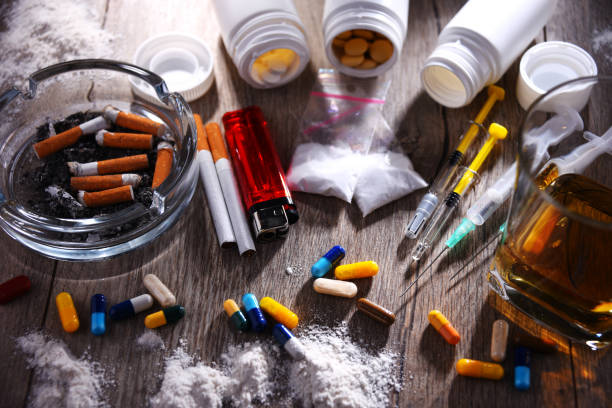
What is LSD?
How does it affect the human body/mind
What are its dangers
What is LSD?
Generic Name: Lysergic acid diethylamide (LSD)
LSD is synthetically made from lysergic acid, which is found in ergot, a fungus that grows on rye and other grains and is mixed with diethylamide.
It is colorless and odorless. A very small amount, equivalent to two grains of salt, is sufficient to produce the drug’s effects.
Swiss chemist Albert Hoffman first synthesized the drug in 1938 to treat respiratory depression. In 1943, Hoffman accidentally discovered its hallucinogenic properties when he absorbed some through his skin.
People can take it orally as capsules, pills, sugar cubes, chewing gum, or liquid drops transferred to colorful blotter paper.
- Acid
- Blots
- Doses
- Dots
- Trips
- Names that reflect the designs on sheets of blotter paper (for example, “purple dragon”). names that describe the kind of trip one may get like Mellow Yellow, Window Pane
How does it affect the human body/mind
The counterculture of the 1960s promoted its use for recreational and enlightenment purposes. Hallucinations are when you see, hear, feel, taste, or smell something that seems real but is not. It is so potent its doses tend to be in the microgram (mcg) range. Its effects, often called a “trip”, can be stimulating, pleasurable, and mind-altering. It some cases it can lead to an unpleasant, sometimes terrifying experience called a “bad trip”.
It activates serotonin receptors in the brain, which stimulates serotonin production in the cortex and deep structures of the brain.
These receptors help visualization and interpretation of the real world. The additional serotonin allows the brain to process more stimuli than usual.
Normally, the brain filters out irrelevant stimuli, but this does not happen with LSD. This overstimulation causes changes in thought, attention, perceptions, and emotions.
Additionally, LSD reduces brain activity in several structures, including the right middle temporal gyrus, anterior cingulate cortex, cerebellum, and left superior frontal and postcentral gyrus.
These alterations appear as hallucinations. Sensations seem real, but the mind creates them.
The perceptions can involve one or more of the five senses: touch, sight, hearing, smell, and taste. Hallucinations can also cause blending of the senses, or synesthesia. People report “hearing” colors and “seeing” sounds.
People using LSD may report having good or bad “trips” or experiences.
- blotter paper (LSD soaked onto sheets of absorbent paper with colorful designs; cut into small, individual dosage units) – the most common form
- thin squares of gelatin (commonly referred to as window panes)
- tablet form (usually small tablets known as Microdots) or capsules
- liquid on sugar cubes
- pure liquid form (may be extremely potent)
Some people may inhale LSD through the nose (snort) or inject it into a vein (shoot it up). There is no way to predict the amount of LSD that is contained in any form consumed.
What are its dangers
The physical effects of LSD are unpredictable from person-to-person. Usually, the first effects of the drug when taken by mouth are felt 30 to 45 minutes after taking it, peak at 2 to 4 hours, and may last 12 hours or longer. Use by the intravenous (IV) route will produce a much quicker action, usually within 10 minutes. Effects include:- hallucinations
- distorted visual perception of shapes, colors
- altered sounds
- anxiety and depression
- flashbacks (a return of the “trip” experience) days or months later
- rapid heart rate, increased body temperature and high blood pressure
- dilated pupils
Extreme changes in mood can occur. If taken in large enough doses, the drug produces delusions and visual hallucinations. Overdose can lead to severe psychosis. Death is often due to a direct injury while under LSD influence. there is no known lethal dose of LSD.
The physical effects can also include- nausea,
- loss of appetite,
- increased blood sugar,
- difficulty sleeping,
- dry mouth,
- tremors and seizures.
The user may also experience impaired depth and time perception, with distorted perception of the size and shape of objects, movements, color, sound, touch and their own body image. Sensations may seem to “cross over,” giving the feeling of hearing colors and seeing sounds. These changes can be frightening and can cause panic. Some LSD users also experience severe, terrifying thoughts and feelings, fear of losing control, and fear of insanity or death. An experience with LSD is referred to as a “trip”. Acute, disturbing psychological effects are known as a “bad trip”. These experiences are lengthy, with the effects of higher doses lasting for 6 to 12 hours, and it may take 24 hours to return to a normal state.
How does Drug Rehabilitation Center help?
The best rehab in India Zorbacare can help by providing the non judgemental acceptance of those affected by the drug. An addict coming off LSD is in a very delicate situation where they sometimes find it hard to recognize reality from the hallucinations they have experienced. Depression is usually a result of coming down from the high and there is anxiety induced when facing realities. At the drug rehab in Mumbai and Pune we ease addicts and alcoholics into real life while bolstering their ability to live life without seeking out the powerful mind altering substances.
